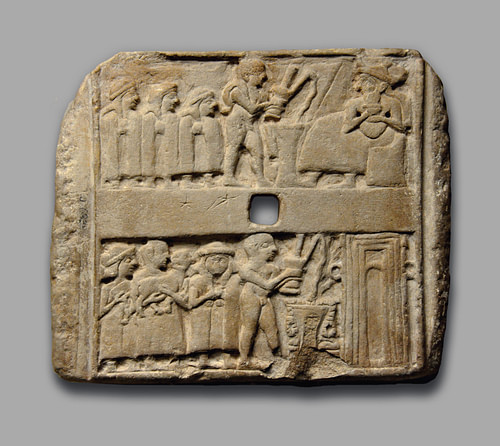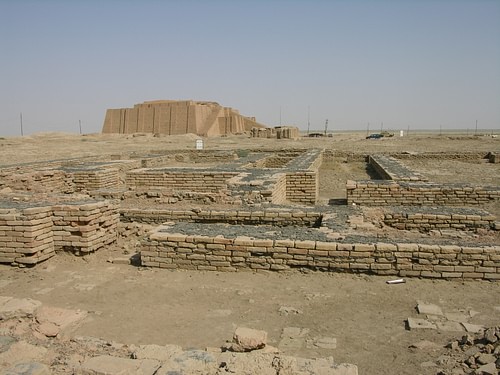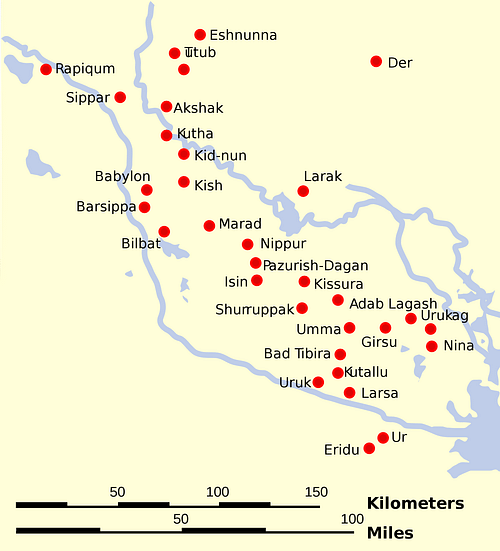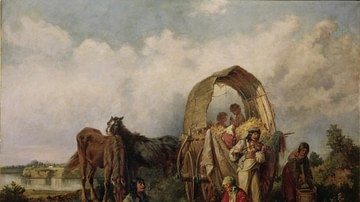
Sumer was the southernmost region of ancient Mesopotamia (modern-day Iraq and Kuwait) which is generally considered the cradle of civilization. The name comes from Akkadian, the language of the north of Mesopotamia, and means “land of the civilized kings.” Sumer is recognized as the birthplace of many of the "firsts" of civilization, including writing.
The Sumerians called themselves “the black headed people” and their land, in cuneiform script, was simply “the land” or “the land of the black headed people”and, in the biblical Book of Genesis, Sumer is known as Shinar.
According to the Sumerian King List, when the gods first gave human beings the gifts necessary for cultivating society, they did so by establishing the city of Eridu in the region of Sumer. While the Sumerian city of Uruk is held to be the oldest city in the world, the ancient Mesopotamians believed that it was Eridu and that it was here that order was established and civilization began.
The Ubaid Period
The region of Sumer was long thought to have been first inhabited around 5000 BCE. This date has been contested in recent years, however, and it now thought that human activity in the area began much earlier. The first settlers were not Sumerians but a people of unknown origin whom archaeologists have termed the Ubaid people - from the excavated mound of al-Ubaid where the artifacts were uncovered which first attested to their existence - or the Proto-Euphrateans which designates them as earlier inhabitants of the region of the Euphrates River.
Whoever these people were, they had already moved from a hunter-gatherer society to an agrarian one prior to 5000 BCE. Excavations from al-Ubaid and other sites throughout southern Iraq have uncovered stone tools from the Ubaid people such as hoes, knives, and adzes and clay artifacts which included sickles, bricks, painted pottery, and figurines.
These people were the first agents of civilization in the region. At what point the people who came to be known as Sumerians entered the area is not known.
The Sumerian King List
According to the scholar Samuel Noah Kramer, “The first ruler of Sumer, whose deeds are recorded, if only in the briefest kind of statement, is a king by the name of Etana of Kish, who may have come to the throne quite early in the third millennium B.C. In the King List he is described as he who stabilized all the lands” (The Sumerians, 43). The Sumerian King List is a cuneiform document, written by a scribe of the city of Lagash, sometime around 2100 BCE which lists all of the kings of the region, and their accomplishments, in an attempt to show continuity of order in society dating back to the beginning of civilization.
As the Mesopotamians generally, and the Sumerians specifically, believed that civilization was the result of the gods' triumph of order over chaos, the King List is thought to have been created to legitimize the reign of a king named Utu-Hegal of Uruk (r. c. 2050 BCE) by showing him as the most recent in a long line of rulers of the region. Etana is famous from the myth of the man who ascends to heaven on the back of an eagle and, like other kings mentioned in the list (Dumuzi and Gilgamesh among them) was known for superhuman feats and heroism.
Utu-Hegal, it is thought, was trying to link himself to such earlier hero-kings through the creation of the King List. Since the Mesopotamians believed that the gods had set everything in motion, and that human beings were created as co-laborers with the gods to maintain order and hold back chaos, the early writers of history in the region concentrated more on the links between the rulers and their gods.
Writing down the history of human accomplishments seems to have been considered a matter of little importance for these writers and, as a result, the early history of Sumer has been deduced from the archaeological and geological record more than a written tradition and much information is still unavailable to modern scholars.
The Rise of Cities
Whenever the Sumerian civilization was first established in the region, by 3600 BCE they had invented the wheel, writing, the sail boat, agricultural processes such as irrigation, and the concept of the city (though China and India also lay claim to `the first cities' in the world). It is generally accepted that the first cities in the world rose in Sumer and, among the most important, were Eridu, Uruk, Ur, Larsa, Isin, Adab, Kullah, Lagash, Nippur, and Kish.
The city of Uruk is held to be the first true city in the world. It has been noted, again by Kramer, that these names are not Sumerian but come from the Ubaid people and so were founded, at least as villages, much earlier than c. 5000 BCE. Other cities in Sumer were Sippar, Shuruppak, Bad-tibira, Girsu, Umma, Urukag, Nina, and Kissura. All were of varying size and scope with Uruk the largest and most powerful at its prime.
With the establishment of the cities of Sumer, their history unfolds from approximately 5000 BCE to 1750 BCE when “the Sumerians ceased to exist as a people” (Kramer) after Sumer was invaded by the Elamites and Amorites. After the Ubaid Period (c. 5000-4100 BCE) came the Uruk Period (4100-2900 BCE) in which cities began to emerge across the landscape and the city of Uruk rose in prominence. Though the period is named for the `first city' of Uruk, Eridu was considered the first city by the Sumerians themselves, as previously noted.
Trade was firmly established with foreign lands at this time and writing evolved from pictograms to cuneiform script. It is thought that trade was the main motivator in the development of writing as there now had to be some means for accurate, long-distance, communication between the merchants of Sumer and their agents abroad. The kingship also arose at this time and the city-states of Sumer came to be ruled by a single monarch who was assisted by a council of elders (which included both men and women). The kings following Etana were Semites, not Sumerians, as attested to by their names such as Enmebaraggesi of Kish. It is not until after the rule of eight kings passed that Sumerian names begin to appear in the King List.
The Akkadian Empire in Sumer
The Early Dynastic Period (2900-2334 BCE) saw the subtle shift from a priest-king (known as an ensi) to a more modern-day concept of `king' known as a Lugal (`big man'). The city-states of Sumer during this time fought for control of arable land and water rights until the rise of the First Dynasty of Lagash in 2500 BCE. Under their king Eannutum, Lagash became the centre of a small empire which included most of Sumer and parts of neighboring Elam.
This empire was still extant under the king Lugal-Zage when a young man, who later claimed to have been the king's gardener, seized the throne. This was Sargon of Akkad who would go on to found the Akkadian Empire (2334-2218 BCE), the first multi-national empire in the world and, it is thought, based on the model set by Eannutum.
The Akkadian Empire ruled over the majority of Mesopotamia, including Sumer, until a people known as the Gutians invaded from the north (the area of modern-day Iran) and destroyed the major cities. The Gutian Period (c. 2218-2047 BCE) is considered a dark age in Sumerian history (and Mesopotamian history overall) and the Gutians were universally reviled by Sumerian writers in later histories, most of which consider them a punishment sent by the gods.
The Sumerian Renaissance
The last period in Sumerian history is known as The Ur III Period (2047-1750 BCE) so named for the Third Dynasty of the city of Ur. This period is also known as The Sumerian Renaissance due to the remarkable advances in culture – touching upon virtually every single aspect of civilized human life – which were made. The kings of Ur, Ur-Nammu (r. 2047-2030 BCE) and Shulgi (r. 2029-1982 BCE)), set cultural advancement as the goal of their administrations and maintained a peace which allowed for art and technology to flourish. Whether invented before or during the Ur III Period, the tools, concepts, and technological innovations in place during the Third Dynasty of Ur solidified the Sumerian's place in history as the creators of civilization as we know it.
In Samuel Noah Kramer's book History Begins at Sumer he lists 39 “firsts' in history from the region among which are the first schools, the first proverbs and sayings, the first messiahs, the first Noah and the Flood stories, the first love song, the first aquarium, the first legal precedents in court cases, the first tale of a dying and resurrected god, the first funeral chants, first biblical parallels, and first moral ideas. The Sumerians also essentially invented time in that their sexigesimal system of counting (a system based on the number 60) created the 60-second minute and the 60-minute hour.
They also divided the night and day into periods of 12 hours, set a limit on a `work day' with a time for beginning and ending, and established the concept of `days off' for holidays. The historian Bertman writes, “The hand of Mesopotamia still determines the hourly length of the traditional workday and even the length of our electronic entertainment (half-hour or hour TV shows) when our workday has stopped” (334). Bertman further notes that the modern day practice of checking one's horoscope comes from ancient Sumer and that the astrological signs one is born under were first noted and named by the ancient Mesopotamians.

Ur-Nammu wrote the first legal code in Sumer which became the precedent for the much later, and better known, Code of Hammurabi of Babylon. The historian Paul Kriwaczek writes, “Ur-Nammu's universal legal pronouncements present a good example of the unifying drive of Ur's kings: the compulsion to regulate every aspect of life” (149). Sumer, under the unifying force of the Third Dynasty of Ur, became a Patrimonial State (“meaning one constructed on the pattern of the patriarchal family ruled by a father figure”, as Kriwaczek notes) in which the monarch served as the father figure who guided his children along a proper path toward prosperity.
Ur-Nammu's son, Shulgi, is considered the greatest of the Neo-Sumerian kings who continued his father's policies but went further. In an effort to both impress his people, and distinguish himself from his father, Shulgi ran 100 miles (160.9 kilometres) between the religious centre of Nippur and the capital city of Ur and back again – in one day – in order to officiate at the festivals in both cities. Though some have considered the hymn which recounts his achievement as a kingly boast and highly exaggerated, scholars have determined that he could, in fact, have made his famous run and, further, that it was in keeping with the spirit of Shulgi's rule. Creating a sense of awe and admiration in their subjects seems to have been central to the governing power of the kings of Ur at this time.
Sumer's Decline & Legacy
Under Shulgi's reign, a wall was constructed 155 miles long (250 kilometres) to keep out the Semitic-speaking tribes known as the Martu or Tidnum but better known by their biblical name of Amorites. Shulgi's son, grandson, and great-grandson all renovated and strengthened the wall to keep those they called `the barbarians' out of Sumer proper but the barrier proved ineffective. The wall could not be properly manned or maintained and, further, was not anchored to any solid barrier at the end points and so invaders could simply follow the wall on the one side to either end point and then walk around it.
The forces of neighboring Elam breached the wall and marched on Ur, sacking it and carrying away the king c. 1750 BCE. The Amorites now established themselves in the land but, with the fall of Ur and a severe famine resulting from climate change and the over-use of the land, many migrated for points south. Among these migrating Amorites, it is thought, was Abraham the patriarch who left Ur to settle in the land of Canaan.
Following the Ur III Period and the fall of Ur, many Sumerians migrated north. Sumerian was no longer spoken as a language (though it was still written), having been largely replaced by the Semitic Akkadian, and the Sumerian culture was ended. Their legacy, however, continues in many aspects of civilization which those in the modern day take for granted as always existing. Even so, something as basic as the twenty-four hour day was invented, once upon a time, in Sumer.












